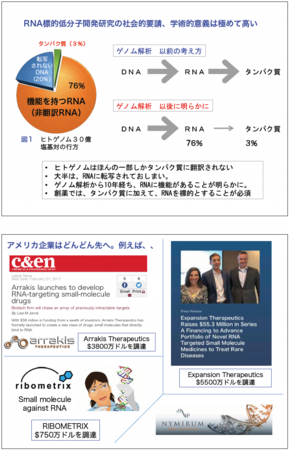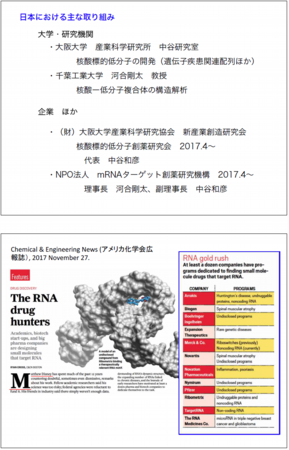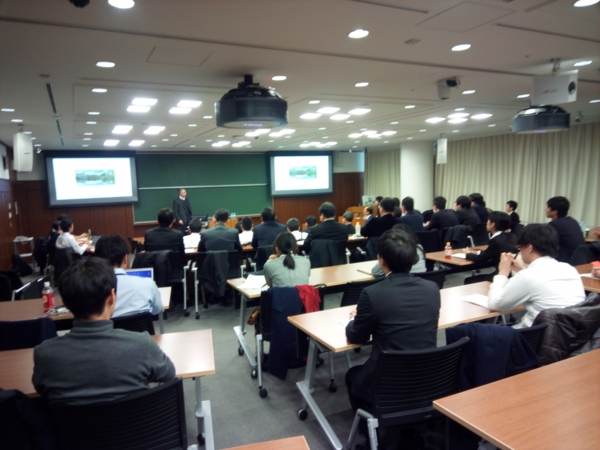核酸を標的とした低分子創薬研究会
(事業終了)
■担当教員
中谷 和彦 教授 (大阪大学 産業科学研究所)
■本研究会のねらい
ヒトゲノムの約8割はRNAに転写され、その多くが非翻訳RNAとして機能しています。mRNAやこの非翻訳RNAを含めたDNA・RNA(以下核酸)は、従来創薬標的とされていた蛋白質とともに、今後重要な創薬標的となると考えられます。核酸を標的とする核酸創薬が盛んに研究されていますが、さらにその次の世代は、核酸を標的とする低分子による「低分子核酸創薬」が、製薬企業各社の開発計画に上がりつつあります。
本研究会では、これから本格的に核酸を標的とした低分子創薬を進めようとする企業研究者を対象として、核酸と低分子の相互作用、核酸を標的とした創薬研究に必要な技術と知識を、少人数の講義形式にて、この分野を代表する講師の方々から直接学んでいただける機会を提供いたします。
本研究会は主に産業科学研究所の中谷研究室のスタッフで企画・運営いたしますとともに、研究者ネットワークを最大限に活かして、素晴らしい講師の方々にお話し頂く予定です。

尚、本研究会設立には、研究分野を代表される以下の先生方にご賛同を頂戴しております。
京都大学 医学研究科 教授 萩原 正敏 先生 (アカデミア創薬)
京都大学 理学研究科 教授 杉山 弘 先生 (低分子によるDNA認識)
横浜国立大学 工学研究院 教授 児嶋 長次郎 先生 (NMR構造解析)
NPO法人「mRNAターゲット創薬研究機構」理事長
千葉工業大学 工学部 教授 河合 剛太 先生 (NMR構造解析)
千葉県がんセンター研究所 所長 長瀬 浩喜 先生 (核酸標的低分子による治療)
(順不同)
開催概要
【令和元年度開催】(2019年度)
第1回 8月6日(火)15:00~18時頃 2019年度第1回研究会.pdf
第2回10月8日(火)14:00~18:30
第3回12月13日(金)15:00~ 2019年度第3回研究会.pdf
【平成30年度開催】 開催案内.pdf
第1回 6月21日(木)午後2時半~ 2018年度第1回研究会.pdf
第2回 8月 7日(火)午後2時~ 2018年度第2回研究会.pdf
第3回 11月12日(月)午後2時~ 2018年度第3回研究会.docx
第4回 3月26日(火)午後3時~ 2018年度第4回研究会.pdf
【平成29年度開催(終了)】 報告書:平成29年度核酸標的低分子創薬研究会開催報告.pdf
第1回 6月15日(木) 午後2時〜
第2回 8月8日(火) 午後3時〜
第3回 10月12日(木) 午後3時〜
第4回 12月15日(金) 午後2時~
【開催場所】
- 富国生命ビル4F まちラボ セミナールーム(大阪市北区小松原町2-4 )他
- (変更になることがありますので、都度ご確認ください。)
入会申込書
ダウンロード:入会申込書(2019年度) (WORD形式)
お問い合わせ
核酸標的低分子創薬研究会
大阪大学産業科学研究協会 事務局
Email: RAIS@sanken.osaka-u.ac.jp
Tel/Fax : 06-6879-8507
核酸を標的とした低分子創薬研究会 第4回
日時: 12月15日(金曜日) 午後2時〜
会場: 富国生命ビル 5F 立命館大学大阪梅田キャンパス 演習室2
プログラム: 第4回ちらし.pdf
1. 挨 拶 研究会企画委員長 中谷 和彦
2. 研究会 #4
米国スクリップス研究所 Matthew David Disney 博士
「Sequence-based rational design of precise small molecules targeting RNA」
懇親会 午後5時頃より
富国生命ビル4F 立食パーティー(会費2千円)
Professor, Department of Chemistry
Graduate Program Faculty Member, Kellogg School of Science and Engineering
Positions:
- Regional Editor for the Americas, Bioorganic and Medicinal Chemistry Letters
-Scientific Advisory Board, The University at Albany The RNA Institute
Education:
B.S., Chemistry, The University of Maryland, College Park, 1997
M.S., Physical Chemistry, The University of Rochester, 1999
Ph.D., Chemistry, The University of Rochester, 2003
Post Doctoral Fellow: The Massachusetts Institute of Technology and
ETH Zürich – Eidgenössische Technische Hochschule Zürich, 2002-2004
Awards and Honors:
• NIH Director’s Pionneer Award, 2016
• Tetrahedron Young Investigator Award in Bioorganic and Medicinal Chemistry, 2016
• David W. Robertson Award in Medicinal Chemistry, 2014
• Excellence Award in the field of Research in Science and Technology. India-US Chamber of Commerce, Inc., South Florida. 2013
講演要旨
Sequence-Based Rational Design of Precise Small Molecules Targeting RNA
Matthew D. Disney
Department of Chemistry
The Scripps Research Institute
A challenge in biomedical research is to rapidly convert genome sequence into lead drugs. In this talk, I describe a series of synergistic approaches that allows one to quickly and accurately convert genome sequence, namely the RNA products of the genome, into lead therapeutic targets. The general approach described herein is very different from typical drug discovery efforts that often rely on screening of a single drug target to identify lead compounds. Rather, it is an attempt to advance a rational, predictable approach to drug disease-causing RNAs with small molecules. I will describe various aspects of this technology that includes the development of rapid screening assays to assess and score the binding of small molecules to RNA folds. The approach is target agnostic but by using this binding information, one can mine the transcriptome (RNA sequence) for these folds to rationally identify druggable RNA targets for small molecules via an approach named Inforna (see: Nat Chem Biol. 2014 Apr;10(4):291-7. doi: 10.1038/nchembio.1452.).
Amongst several advances in this area, we will describe efforts to design bioactive small molecules that target cancer-causing non-coding RNAs and, if time permits, RNA repeat expansions that cause incurable rare disease. For example, small molecules have been rationally designed to target oncogenic microRNA-96 (see: Nat. Chem. Biol. 2014. 10(4):291-7. doi: 10.1038/nchembio.1452 and Proc. Natl. Acad. Sci. U.S.A. 2016. 113(21):5898-903. doi: 10.1073/pnas.1523975113.), -210 (J. Am. Chem. Soc. 2017. 139(9):3446-3455. doi: 10.1021/jacs.6b11273.), and -18a (ACS Central Science. 2017. 3(3):205-216. doi: 10.1021/acscentsci.7b00009) that are causative of various cancers including breast and prostate. In addition, chemical approaches to identify the on- and off-targets of small molecules targeting RNA will be presented, namely Chemical-Cross-Linking and Isolation by Pull Down (Chem-CLIP, J. Am. Chem. Soc. 2017. 139(9):3446-3455. doi: 10.1021/jacs.6b11273, and others). This approach has demonstrated selective binding of small molecules to the RNAs to which the compounds were designed to target in cells. Chem-CLIP and other studies have also elucidated factors affecting the ability of small molecules to selectively and potently target microRNA precursors. Lastly, the ability of these compounds to affect tumor burden in mouse models of cancer will be presented and the activities of these small molecules compared to that of antagormirs, which recognize their target via Watson-Crick base pairing to mature microRNAs. In summary, it appears that non-coding microRNA precursors may be more druggable with small molecules via rational and predictable approaches than previously realized.
【開催場所】
- 富国生命ビル5F
- (大阪市北区小松原町2-4 )
参加申込書 ダウンロード(WORD形式)
お問い合わせ
核酸標的低分子創薬研究会
大阪大学産業科学研究協会 事務局
Email: RAIS@sanken.osaka-u.ac.jp
Tel/Fax : 06-6948-6902


